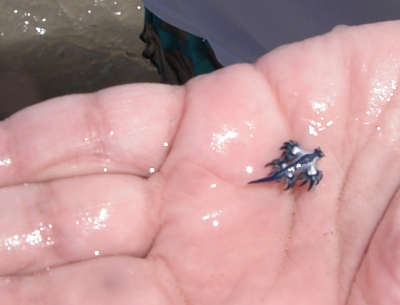Glaucus atlanticushttp://en.wikipedia.org/wiki/Glaucus_atlanticusGlaucus atlanticus is a species of medium-sized, floating, blue sea slug, a pelagic aeolid nudibranch, a marine opisthobranch gastropod mollusk in the family Glaucidae.
G. atlanticus preys on other larger pelagic organisms: the dangerously venomous Portuguese Man o' War Physalia physalis; the by-the-wind-sailor Velella velella; the blue button Porpita porpita; and the violet snail, Janthina janthina. Occasionally, as in many other nudibranchs, individual Glaucus will cannibalize each other if given the opportunity.
G. atlanticus is able to feed on P. physalis due to its immunity to the venomous nematocysts. The blue sea slug will consume the entire organism and appears to select and store the most venomous nematocysts for their own use. The venom is collected in specialized sacs (cnidosacs), on the tip of their cerata, the thin feather-like "fingers" on its body. Because Glaucus stores the venom, it can produce a more powerful and deadly sting than the Man o' War upon which it feeds.
With the aid of a gas-filled sac located in its stomach, G. atlanticus is able to stay afloat at the surface. Due to the location of the gas sac the blue sea slug actually floats upside down. The dorsal surface, actually the foot and underside, has either a blue or blue-white coloration. The true dorsal surface is completely silver-grey. This coloration is an example of counter-shading, which helps protect G. atlanticus from predators from below,sides and above.
Scientists have often argued over whether G. atlanticus moves on its own or depends on the wind for locomotion.
Glaucus is, like most sea slugs, a hermaphrodite, meaning it contains both male and female reproductive organs. After mating, both slugs will produce egg strings.
-----
Needless to say, the Glaucus looks weird.




 Author
Topic: Amazing nature (Read 69426 times)
Author
Topic: Amazing nature (Read 69426 times)
